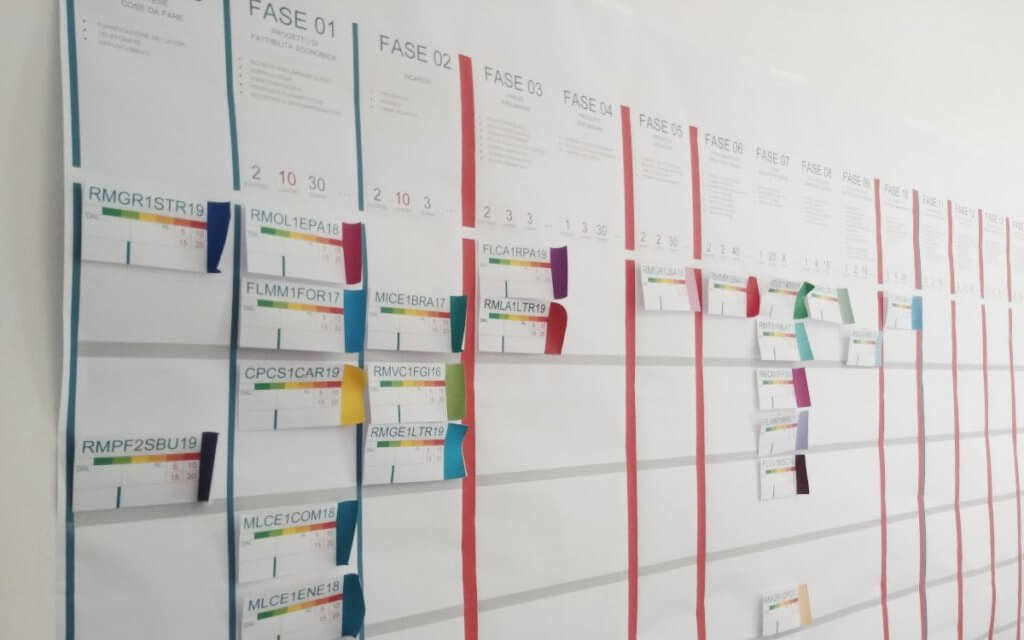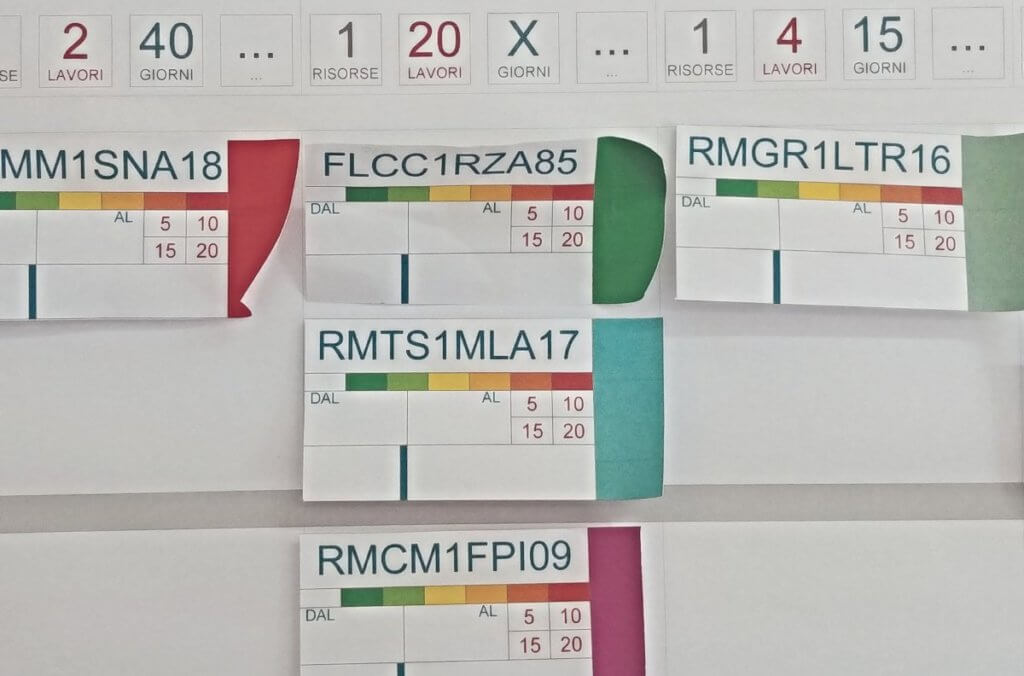3 . Kanban…in architecture?
One more time, Agile goes way beyond Software or IT

By Valerio Zanini
After climbing 436 steps, going through narrow corridors that were designed for maintenance workers and not for the comfort of today’s tourists, and winning a growing sense of dizziness with the increasing height, we reached the top of the dome.
The view was magnificent, with the blue sky and the green hills acting as backdrop for one of the most beautiful cities in the world. We were in Florence, on top of the cathedral -the breathtaking Cathedral of Santa Maria del Fiore.
Not much has changed here since it was completed 500 years ago, and in a sense the climb to the top was like traveling back in time. The terracotta roofs of the city, viewed from the top, red and preserved throughout the centuries, provided a sense of stability when viewed from above.

I was visiting Florence with my family and my parents, taking them for a few days away from the busy life of Rome. It was an opportunity to enjoy time together, bond, and share stories.
While we were up on the dome, my parents waited downstairs, in the comfort of a small open-air table outside of a coffee shop. When we finally came back to base, everyone was hungry. So we ventured in the small side streets of the city, and found a small restaurant that reminded us of the comfort smells of good pasta and red meat. And after a few appetizers and a glass of red wine, I asked my dad “How is work?”
My father runs an architecture firm in Rome. He and my Mom co-founded it more than thirty years ago and, over the years, grew it to one of the most respected in Rome. He employs several people, including my younger brother, who over time has taken more and more responsibilities to manage the company and the day-to-day execution of the work. With growth came the headaches of managing complexity and losing visibility into everything that goes on.
You see, my father is not one to easily complain about problems or gossip about other people. He has a positive attitude towards life, looking for the good in everyone and in every situation. So when he replied “Not so well. I’m really struggling to keep up with everything that’s going on”, I knew that the red wine had won over his natural resistance to be completely honest, and what he was about to share came from a pain point.
Projects in architecture have a long-life cycle. Customer desires, ideas, and requirements get transformed into preliminary designs, and then into detailed blueprints. Permits must be acquired before any work can begin. And depending on the location and the specific construction, there may be additional constraints that require multiple requests to other institutions responsible for preserving the environment and the artistic heritage, or ensuring compliance with safety laws.
For large projects, approvals may be requested in phases, and often blueprints get updated between phases as changes and new ideas surface from the work already underway. Whenever a blueprint is updated, requests for permits need to start over. And any delay in permits may create stress and strains with the construction company or with the customers.
Managing the workflow for a project is already a complex job. But when the firm works on multiple projects at the same time – which is normal for a firm this size – keeping up with everything that’s going on, where each project is, and what needs to be done next, is daunting. That’s what my father was explaining to me over lunch that day in Florence.
“And, above all that, with multiple people managing their own piece of the work, I am really struggling to see the big picture, to know the status of each project, and to know who is doing what. I get really frustrated, ending up working more than I should, or picking up on your brother even if it’s not his fault.” – he concluded. We drank a sip of wine to let the thoughts sink.
I told him, “Dad, I think I can help. We should create a Kanban board to generate transparency on all your projects, and on the flow of work.”
He had no idea what Kanban was, but he has always been curious to learn more about new things. After a brief explanation, he said, “OK, let’s try it when we get back to the office.”
Setting up the Kanban
Back in Rome, my father and my brother asked me to explain Kanban in greater detail. We were meeting in their office, in a small conference room typically used for management meetings. I only had a couple of days remaining in my vacation in Italy before returning to the US, and wanted at least to help them understand how to get started.
“Kanban is used to visualize and manage the flow of work. It allows you to know where each project is at each moment in time, and how many projects or tasks you have open. It also provides you actionable information to decide where to focus your efforts so that you can move a specific project forward. It starts with visualizing your workflow.” – I explained
“How do we do this?” – my father asked
“Let’s start with visualizing the steps it takes for work to be completed. Let’s take a few blank cards and see if we can start putting something together quickly. You may need to revisit and expand this later, but it’s good to start from something practical.”
During the next fifteen minutes we jotted down on cards the steps of a typical project. From meeting with the customer to defining the initial requirements, to creating an initial draft of the design, getting the contract signed, designing the blueprints, getting the permits, and the various stages of construction.
When we listed all the steps, we realized that there were at least fifteen steps and possibly more. Each step had a different timeline, for example the initial meeting with the customer could be done within a few days, whereas some of the more complex permits required months.
I continued, “I want to create a list of all possible steps a project may go through. It doesn’t mean that all projects go through all the steps – in fact, some may skip a few when the steps don’t apply to them. We can even add some description to each step to know what type of projects belong to each step.”
We also spoke about policies, “How do you know when the work in any given step is completed? For example, how do you know when the contract phase is completed?” – I asked
“Well, that’s easy: it’s when the customer signs the contract!” – replied my brother with a chuckle
“Great. That’s a clear policy. For each project that is in that phase, we can check for the contract signing and when that happens, we know the project can move forward to the next phase. What about the permit phase?”
“That’s more complex. It depends on what type of permit we are talking about. Some permits are straightforward. Not that they are fast – everything needs time. But all we need to do is present the blueprints, make the request, and then wait. At some point they get approved. For some kinds of projects, we may need other permits, and these may require going from one office to another, or even to different institutions. These are way more complicated, and sometimes they never get approved. After waiting months, we may need to go back to the drawing board, and start the process again.” – continued my brother.

Once we had created the workflow and the policies for each step, I explained the purpose of WIP (Work in Progress) Limits.
“A WIP Limit is the maximum number of projects that can be in any given step or column on the board. Why this is important is to reduce multitasking and create focus. Without a WIP Limit you may end up working on too many projects at the same time and get overwhelmed, which is basically how you operate today.”
“Yes, in fact we start working on a project as soon as we get it, even if we have ten other projects already open, and then we struggle to keep up with everything.” – confirmed my father with a somewhat somber tone.
“What would open up for you – let’s say for example – if you put a WIP Limit of three, meaning that you only work on a maximum of three projects at a time?”
“It would be a dream. It would be so much easier. But for us it’s not possible, because some projects may sit for months in an office waiting for a permit, and we can’t afford to not start other projects in the meantime” – replied my father
“Yes, that is the true nature of work. Some projects may require active work on your part, for example when designing the blueprints. In this phase, you may decide to only work on two projects at a time. Other projects may be in that long phase of waiting for permits. If you have five or even ten projects sitting there while waiting for approvals, it does not require any active work for you, so you can have a higher WIP Limit. Then, when a project emerges from permit approval, and you need to work on it for construction, you may want to focus again on just one or two projects at a time. Get them done, and then start the next one.”
“So, basically, we can have different WIP Limits for each step” – asked my brother who was starting to see the puzzle come together.
“Yes, that’s the idea. Each step has a different WIP Limit depending on the level of focus and effort required on your end, as well as the capacity, or time, that you feel that you have to undertake the task” – I explained.
This first meeting served to plant the seed. We had a few other conversations in the next couple of weeks, and continued the conversation even after I returned to the US. In the meantime, they were reflecting on what they had learned, and discovering together how best they could implement the Kanban method.
Back in the office, they cleaned up one long wall, creating the space for a Kanban board. They tested a few different variations, learning about the different steps in the workflow and how best to represent them.
Going through this work had the side benefit of creating increased understanding among everyone in the firm about the work that was required in each step. Some people had different expectations and the conversations helped them get aligned as a team. They wrote down the policies for each step and this contributed to further the alignment and the transparency. By putting everything together and visualizing it on the wall, everyone generated a full understanding of what the work entails.
Bringing projects to life
The next step was to create cards for each project, and then put them on the board in the phase corresponding to where each project was at the time. The cards were used to track the progress of each project, and to spark conversations within the team for what they should be working on next.
A first challenge came from the names of the cards. The firm has an open space policy where customers can visit the working space of the team. It meant the team did not want customers to see their own names on the cards, so the team came up with a coding strategy to mask the real names and yet understand who the customers were for each project.
The team also established criteria for timing, setting up expectations for the duration of each phase, and adding a space on the cards to identify if any project was running late compared to the expectations. All this work was the result of multiple attempts, until they found a format that worked well for them.

Over several weeks, the team iterated further on the structure of the Kanban board, adding details that included the maximum number of people that should work together on any given stage of a project, the expected duration of each phase, and a tracker to signal when the time was above the expected limit. All these helped to increase transparency and collaboration between team members.
Working with the Kanban
Once the Kanban board had been set up on the wall and all projects had been mapped with individual cards on the board, my father called me. “This is probably the first time I have the full visibility of where every project stands, what to expect, and when to expect it.”
Then, he added, “Before, individual owners knew parts of each project, but no one had full visibility, and I had to go around asking a bunch of people. It was stressful. Now, I just need to glance at the board, and I get it. I feel more relaxed and confident – confident that we have things under control and I don’t need to stress to understand where projects are. Our conversations are now about the work we need to do, and not about trying to figure out who’s doing what and where everything stands.”
These are the benefits that implementing Kanban can provide. It does not matter the industry or the specific work you do. By creating visibility and collaboration on the work at hand and its status, and by managing the flow of work, teams can identify bottlenecks and constraints, create alignment, focus on the important work, and in general, improve productivity and trust within the team.
Building the Kanban board and mapping out all work on it is the first step. Of course, setting up the right processes to manage, update, and share the work is equally important.
I asked “Do you review the board together with the rest of the team?”
And he replied “No, normally I look at it on my own to get the information I need about the status of each project.”
“That’s good, I’m glad that’s working for you, Dad. Let me offer one additional suggestion, to help you and your team benefit from this work and keep alignment. I suggest that you do a daily stand-up in front of the board. Everyone participates. You could do it first thing in the morning. The idea is that you look at the different projects you have in progress, and discuss what the team needs to work on in order to move forward with any of those projects.”
“I like the idea, so that it’s no longer just me looking at it, but rather it’s the whole team. And we keep each other aligned. I want to discuss with the team what the right cadence for this should be.”
“Yes, and if it’s not every day, that’s ok. The value of this is to inspect the progress of the work and decide – together – where to focus on and what to do to advance any of the projects.”
The team does a stand-up on a weekly basis. This is what works for them given the nature of the work and the fact that they often spend entire days outside of the office working at construction sites or at the permit offices. The weekly ritual in front of the Kanban board has become that opportunity for everyone to get together, share updates, and align on the work to be done.
They are no longer chasing the projects and trying to figure out what to do and the status of each one. They can focus on the work that needs to be done, trusting that everyone on the team knows what everyone else is doing, and prioritizing the work that is valuable.
A few months later, my father called me, “I’d like to send you a few photos of our Kanban board. It has saved my sanity and my team. I’m proud of all the work we have done on it.”

FOR BEGINNERS AND CURIOUS
- Yes, Kanban is a method to visualize and track work.
- Yes, it helps teams focus on what matters, drive collaboration, and improve productivity.
- Yes, it can be used across a variety of projects and industries, from software development to architectural projects.
I am Valerio Zanini and these are my agile-thoughts
2021 © Rome, ITALY by Valerio Zanini

Valerio is passionate about building great products that customers love. He consults with and trains product teams on topics of product management and innovation.
His passion is for creating digital experiences that customers love and supporting the teams that make the magic real.
In his spare time, he is the executive producer of Hustle & Grind, a TV series that showcases real stories from real entrepreneurs with the goal of inspiring others to embrace entrepreneurship.
